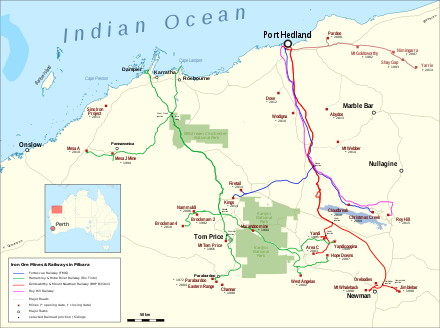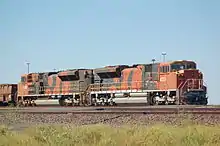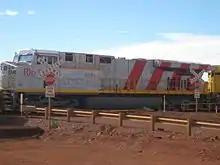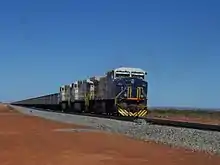Pilbara railways
The Pilbara railways are a collection of railways in the Pilbara region of north-west Western Australia.
History





In 1887, the Cossack Tram opened[1] followed by the Western Australian Government Railways's (WAGR) Marble Bar Railway in 1911. However these had closed by the 1950s.
Following the opening up (by the WA government) of the Pilbara region for mining in the 1960s, four companies began to mine and export the iron ore. Because of the distances from the mines to the sea ports, railways were built as the most economical method to transport the ore. Unlike other lines in Western Australia that were built to narrow-gauge, all of the Pilbara lines were built to the Association of American Railroads' standard-gauge for both track and rollingstock loading gauge.[2] This came about because it was determined by the iron ore industry that the required duty was going to be "heavy-haul" and it was considered that the track structure and rollingstock needed to be to standard-gauge scale. These "railroads" (as they were called) were built by a U.S. railroad construction joint venture, Morrison-Knudsen-Mannix-Oman (MKMO).[3]
The first company to commence operations in June 1966 was Goldsworthy Mining Ltd with a line from Mount Goldsworthy to Finucane Island. In August 1966, Hamersley Iron (a Rio Tinto company) opened a 298-kilometre line from Mount Tom Price to a new port at East Intercourse Island, near Dampier. This was extended shortly after by 100 kilometres to a second mine at Paraburdoo. In March 1969, the Mount Newman Mining Pty Ltd joint venture began operating a 427-kilometre line from its Mount Whaleback mine to Port Hedland. The Cliffs Robe River Iron Associates joint venture opened a 162-kilometre line from Mount Enid to Cape Lambert, near Wickham, in July 1972.[2]
Since then, the iron ore trackage has been expanded as new mines have opened. With mergers and takeovers, there has been considerable consolidation of mine (and railroad trackage) ownership, particularly with BHP Billiton Iron Ore Pty Ltd and Rio Tinto.[4]
On 21 June 2001, eight BHP Billiton GE AC6000CWs combined to set the world record for the longest and heaviest train; hauling a 682-car, 99,734 gross-tonne (82,000 tonnes of ore), 7.3 kilometre-long train.[5]
In April 2008, Fortescue Metals Group opened a line from Cloud Break mine to Port Hedland.[6] In November 2015, Hancock Prospecting will open a 344 kilometre line from Roy Hill.[7]
As at early 2014, iron ore trackage in the Pilbara was 2,295 kilometres long. It accounted for 94% of all Australian iron ore exports.[8]
In 2013, Aurizon in conjunction with Brockman Mining and Atlas Iron under an Alliance Study Agreement, completed a study for a new independent iron ore railway in the Pilbara.[9]
Rollingstock
Goldsworthy Mining Ltd operated locomotives to the same design as the WAGR H and K classes as well as one EMD JT42C (GML10, based on both the VicRail N and Australian National DL classes).
The other three mining companies operate larger locomotives built to take advantage of the Association of American Railroads loading gauge. Some were built under licence in Australia by AE Goodwin, Comeng, and rebuilt by A Goninan & Co and Clyde Engineering, however most have been imported from the United States.[2]
Locomotives operated have included members of the following classes:
Ports
The large-tonnage heavy-duty iron ore railways require deep-water ports, which have to accommodate very high tidal ranges.
- Port Hedland
- Goldsworthy – now closed
- Shay Gap
- Yarrie mine
In development
- Anketell Port, near Cape Lambert
Engineering heritage award
The heavy haul railways received an Engineering Heritage International Marker from Engineers Australia as part of its Engineering Heritage Recognition Program.[10]
References
- From the Past The Daily News 4 April 1914
- Oberg, Leon (1980). Diesel Locomotives of Australia. Terrey Hills: AH & AW Reed. pp. 65/66. ISBN 0 589 502115.
- Construction of the Mt. Newman Iron Ore Railroad by Norman Leslie Smithson and Driving the last spike – official opening of the Mt Newman Iron Ore Railroad, 22 January 1969 by Norman Leslie Smithson
- Joyce, John; Tilley, Allan, (joint author.) (1980), Railways in the Pilbara, J & A Publications, retrieved 21 March 2015CS1 maint: multiple names: authors list (link)
- BHP breaks its own 'heaviest train' record Railway Gazette International 1 August 2001
- Fortescue opens the world's heaviest haul railway Railway Gazette International 14 July 2008
- Rail Roy Hill
- Trainline 2 Statistical Report Bureau of Infrastructure Transport & Regional Economics 2014 page 21
- East Pilbara Independent Railway Aurizon
- "Pilbara Heavy Haul Railways". Engineers Australia. Retrieved 7 May 2020.